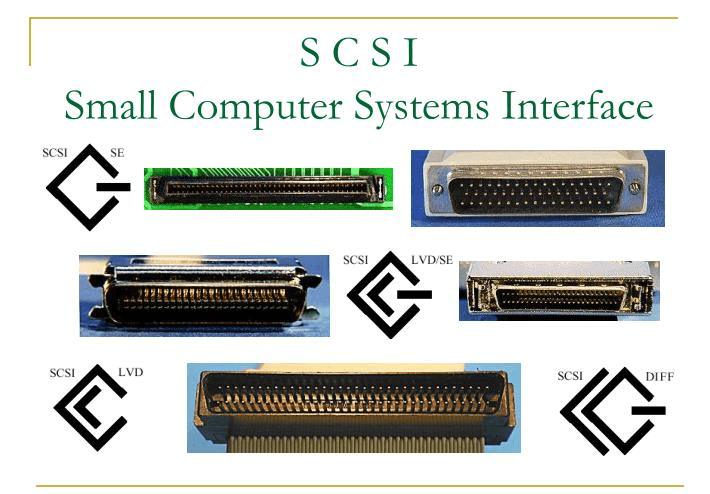Small Computer System InterfaceThe basic interface for connecting peripheral devices to a PC is a small computer system interface. Based on the specification, it can typically respond up to 16 external devices using a single route, along with a host adapter. Small Computer System Interface is used to boost performance, deliver fast data transfer delivery and provide wider expansion for machines like CD-ROM drivers, scanners, DVD> drives and CD writers. Small Computer System Interface is most commonly used for RAID, servers, highly efficient desktop computers, and storage area networks. The Small Computer System Interface has control, which is responsible for transmitting data across the Small Computer System Interface bus and the computers. It can be fixed on a motherboard, or one client adapter is installed through an extension on the computer's motherboard. The controller also incorporates a simple SCSI input/output system, which is a small chip that provides access and control equipment with the necessary software. The SCSI ID is his number. Using serial storage architecture initiators, new serial SCSI IDs such as serial attached SCSI use an automatic process which assigns a 7-bit number. 
Serial-attached SCSISAS goods are compliant with appliances that use previous SCSI technology. The Serial Storage Architecture standard can be used if SCSI performance is not appropriate, as can iSCSI, which preserves the SCSI command set by embedding SCSI-3 over TCP/IP. In enterprise environments, SAS has become a common alternative to parallel SCSI. Serial and parallel small computer system interface are both based on the set of SCSI commands. SAS provides the following unique benefits over parallel SCSI: Through buses and interfaces, peripheral devices are connected to the CPU, and the most common interface for connecting these devices is SCSI. Compared to the parallel data transfer interfaces used in earlier days, SCSI was revolutionary technology in terms of data transfer and compatibility. SCSI also provides backward compatibility when systems are compliant with the previous SCSI edition. A modern variant of SCSI can also be connected to these machines, although the data transfer rate would be higher. A SCSI parallel bus was used for the original SCSI. In 2008, the Serial SCSI architecture, which is faster and more stable than the parallel SCSI bus, was implemented. Internet SCSI used Internet protocol. This design does not have any physical features. It transmits data through TCP/IP. The Shugart Associates Machine Interface developed SCSI in 1978 and industrialized it in 1981. The founder of this technology was Larry Boucher, once employed for Shugart Associates, then subsequently for Adaptec, a company that produces SCSI, serial attached SCSI, and supporting host adapters. For data transmission, the SASI was developed as an interface between an HDD and a host PC. Utilizing an 8-bit parity bus, it had a 50-pin ribbon plug and supported up to 8 devices. The SASI sent data in blocks with a 5 MHz clock speed and ran asynchronously in synchronous mode at 3.5 MB/ps or 5 MB/ps. By 2000, the Ultra 640 SCSI had a 160 MHz clock speed, creating parallel cabling problems. The serial SCSI was changed to fix the error. Device links are now hot-swappable plus compliant at a lower cost for serial advanced technology attachment. The clock speed increased to 4 GHz using the arbitrated fiber channel loop and optical fiber cables. Using one socket, the SCSI can support external and internal SCSI devices. There are usually two or three 50, 68 or 80 pin sockets for the internal parallel SCSI ribbon wire. A port is used by external devices. Depending on the SCSI bus standard, the external cable is always shielded and has 50 or 69 pin sockets on each end. There is also a single connector attachment, which contains two variations of an internal connection. A single daisy chain is supported by both SCSI devices and the host adapter. In a sequence of nodes, a daisy chain ties the modules one after the other using a hardware setup. Depending on the SCSI version, the SCSI Graphic User Interface (GUI) supports different devices. A daisy chain's advantage is the ability to add an extra node anywhere on the chain. One or more signals may be modified by each unit in the chain before being sent to the next unit. Sixteen computers are supported by SCSI-2, 5 to 8 are supported by super SCSI, and 16 are supported by ultra-320 SCSI.
Next TopicWhat is Cyber Law
|
 For Videos Join Our Youtube Channel: Join Now
For Videos Join Our Youtube Channel: Join Now
Feedback
- Send your Feedback to [email protected]
Help Others, Please Share









